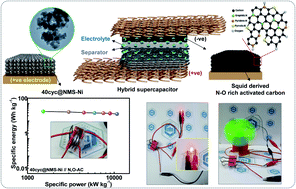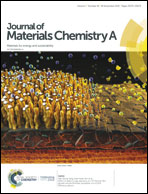Selective design of binder-free hierarchical nickel molybdenum sulfide as a novel battery-type material for hybrid supercapacitors†
Abstract
Recently, binder-free and hierarchical electrode materials have attracted special attention for the rational design of high-energy density hybrid supercapacitors. Herein, we demonstrated binder-free nickel molybdenum sulfide nano-flakes on nickel foam (NMS-Ni) using a facile successive ionic layer adsorption and reaction (SILAR) process for the fabrication of high-performance hybrid supercapacitors. The selective SILAR cycles had a significant effect on the morphology and electrochemical properties of the NMS nanostructures. Specifically, the NMS deposited for 40 cycles (40cyc@NMS-Ni) displayed the maximum areal capacity (CAc) of 2.8 C cm−2 (2224 C g−1) at the current density 4 mA cm−2 in a 6 M KOH electrolyte. Furthermore, a hybrid supercapacitor (HSC) was fabricated using 40cyc@NMS-Ni as the positive electrode and N,O-enriched activated carbon (N,O-AC)-coated Ni-foam as the negative electrode, which showed the maximum potential and specific capacitance (CF-cell) of 1.5 V and 111 F g−1, respectively. Moreover, the device displayed an outstanding specific energy and specific power of 35 W h kg−1 and 1.5 kW kg−1 with an excellent capacitance retention (95%) after 5000 cycles, respectively. Thus, based on the observed results, it can be concluded that the present study demonstrates a route to utilize NMS-based electrodes as a promising material for high-performance energy storage devices.



 Please wait while we load your content...
Please wait while we load your content...